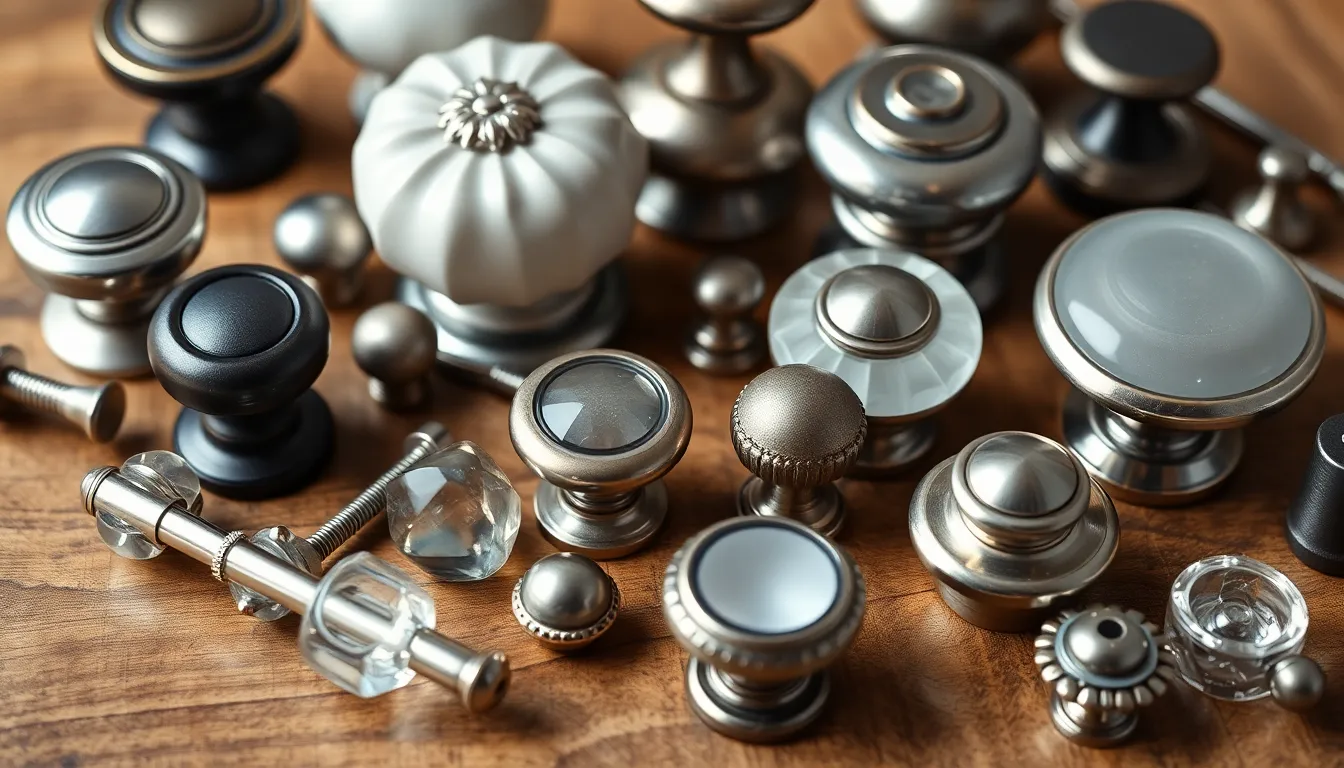When it comes to home improvement, cabinet hardware might not be the first thing that pops into mind. Yet, it’s the unsung hero of any kitchen or bathroom. Picture this: a beautifully renovated space, but those outdated cabinet knobs are like wearing flip-flops with a tuxedo. Not exactly the statement you want to make.
Table of Contents
ToggleOverview of Cabinet Hardware
Cabinet hardware includes essential components such as knobs, pulls, and hinges that enhance functionality and style. Knobs typically offer a classic look, while pulls provide a modern touch, allowing homeowners to choose based on their design preferences. Hinges play a critical role in cabinet operation, with options ranging from concealed to overlay styles that suit various cabinet designs.
Materials used in cabinet hardware range widely. Metals like stainless steel and brass offer durability, while ceramic and glass add a decorative flair. Each material type influences both aesthetics and longevity, impacting the decision-making process for renovations.
Finishes also vary significantly, contributing to the overall appearance of cabinetry. Matte, satin, and polished finishes create distinct visual effects. While polished surfaces reflect light and enhance design drama, matte finishes promote subtle sophistication.
Sizes and shapes come in diverse options, ensuring compatibility with different cabinet styles. Standard knob sizes typically range from 1 inch to 1.5 inches in diameter, while pulls can measure anywhere from 3 inches to 12 inches in center-to-center spacing. Unique shapes, such as geometric or vintage designs, allow for personal expression within kitchen and bathroom spaces.
Installation of cabinet hardware requires attention to detail. Aligning hardware symmetrically on doors and drawers ensures a professional appearance. Proper measurement and marking simplify the process, keeping installation straightforward and efficient.
Choosing the right cabinet hardware can transform a space. Homeowners enhance their overall décor while improving functionality by selecting hardware that reflects personal style and fits seamlessly within the design.
Types of Cabinet Hardware

Cabinet hardware encompasses several essential components. Each type contributes to both functionality and aesthetic appeal.
Cabinet Knobs
Cabinet knobs provide a classic look that suits various cabinet styles. These small fixtures attach easily to cabinet doors and drawers. Made from materials such as metals, ceramics, or glass, knobs offer versatility in design. Homeowners should consider size and shape to ensure comfort during use. For instance, round knobs provide a traditional feel, while square or geometrical shapes deliver a modern twist. Finishes range from matte to polished, allowing for further customization.
Cabinet Pulls
Cabinet pulls present a solution for those seeking a contemporary design. These longer hardware pieces allow for a better grip on larger drawers and doors. Materials such as brushed nickel, brass, and even acrylic enhance their appeal. Pulls vary in lengths, ensuring compatibility with different cabinet sizes and designs. Opt for styles such as finger pulls for a minimalist look or ornate designs for a statement piece. The choice of finish can also elevate the overall theme of the cabinetry.
Hinges
Hinges play a vital role in cabinet functionality, enabling smooth opening and closing. Various types exist, including concealed, pivot, and European hinges. Concealed hinges provide a clean look, hiding the hardware from sight. In contrast, decorative hinges can enhance visual interest. Quality hinges ensure durability and a seamless operation over time. Mounting options differ, allowing for compatibility with various cabinet constructions. Choosing the right hinge type significantly affects both usability and style.
Materials Used in Cabinet Hardware
Cabinet hardware utilizes a variety of materials, each contributing to functionality and style. Understanding these options helps in making informed design decisions.
Metal Options
Stainless steel remains a popular choice due to its durability and resistance to corrosion. Brass, known for its warm tones, offers an elegant touch that suits traditional and modern designs alike. Many prefer matte finishes for a contemporary look, while polished metal provides a more classic shine. Iron is often used for rustic designs, giving an industrial feel. Each metal provides various advantages in terms of maintenance, strength, and aesthetic appeal.
Plastic and Acrylic
Plastic options are lightweight and budget-friendly, making them an excellent choice for renovations. Acrylic hardware often mimics glass, providing a chic appearance without the fragility. Many manufacturers offer vibrant colors and unique designs in plastic, appealing to creative preferences. Easy installation makes plastic hardware ideal for DIY projects. Both materials resist fading and impact, ensuring longevity in high-traffic areas.
Wood and Composite
Wood hardware adds a natural warmth that complements traditional and rustic cabinetry. Various woods, such as oak and maple, offer distinct grains and finishes, enhancing the overall design. Composite options provide a sturdy alternative, often designed to imitate wood while resisting wear. These materials excel in environments where moisture resistance is essential. The unique textures and colors available with wood and composite hardware allow for personalized touches in home decor.
Choosing the Right Cabinet Hardware
Selecting the appropriate cabinet hardware involves thoughtful consideration of style and size, as these elements impact both aesthetics and functionality.
Style Considerations
Design preferences play a crucial role in choosing cabinet hardware. Traditional settings often benefit from classic knobs, enhancing the timeless charm of the space. Contemporary designs may favor sleek pulls, complementing a minimalist aesthetic. Decorative elements, such as ceramic or glass finishes, contribute unique touches, allowing homeowners to express individuality. Opting for finishes like matte or polished creates a cohesive look with cabinetry. Since various materials exist, including stainless steel and brass, selecting hardware that aligns with the overall theme becomes essential. Matching hardware style with cabinetry design fosters harmony, enhancing the visual appeal of kitchens and bathrooms.
Size and Scale
Proper dimensions matter significantly when selecting cabinet hardware. Small knobs may suit petite cabinets, while larger pulls often work better on spacious drawers. Measuring existing placements ensures new hardware fits seamlessly and functions well. It’s advisable to consider ergonomic aspects, especially for heavy-use areas. Width and length of pulls should facilitate easy access without overwhelming the space. Furthermore, proportionate hardware complements cabinet size and enhances usability. A balance between visual presence and practicality ensures that the chosen hardware effectively enhances both decor and function.
Maintaining Cabinet Hardware
Proper maintenance of cabinet hardware ensures longevity and enhances aesthetic appeal. Regular care and timely replacements keep fixtures functional and visually pleasing.
Cleaning Tips
Cleaning cabinet hardware requires specific techniques. Use a soft cloth to wipe down hardware regularly, preventing dust accumulation. For tougher grime, a mixture of mild soap and warm water works effectively. Avoid abrasive cleaners, as they can scratch surfaces. Dry the hardware immediately after cleaning to prevent water spots or rust. When cleaning, pay attention to crevices where dirt can hide; a soft-bristled brush can assist in these areas. Frequent maintenance not only preserves the appearance but also prolongs the life of the hardware.
When to Replace
Recognizing when to replace cabinet hardware is essential for maintaining functionality. If knobs or pulls feel loose or wobbly, it indicates a need for replacement. Corrosion or tarnishing on metal elements signals degradation, often requiring immediate attention. Sticky or difficult-to-open hardware can hinder usability; replacing it enhances the overall user experience. A fresh look can also refresh dated décor. Consider replacing hardware every few years for a modern touch or during kitchen and bathroom renovations for unified aesthetics. Each piece should complement the rest, ensuring harmony in design and functionality.
Cabinet hardware plays a pivotal role in defining the character of a space. By selecting the right knobs, pulls, and hinges, homeowners can elevate their interiors from ordinary to extraordinary. The variety of materials and finishes available allows for endless customization, ensuring that each choice aligns with personal style and design vision.
Proper installation and maintenance of cabinet hardware further enhance its impact, creating a polished and cohesive look. As trends evolve, updating this often-overlooked detail can breathe new life into kitchens and bathrooms. Ultimately, investing time and thought into cabinet hardware decisions can lead to a beautifully curated home that reflects individual taste and functionality.


